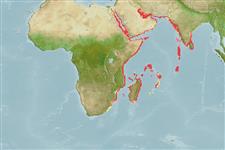>
Eupercaria/misc (Various families in series Eupercaria) >
Haemulidae (Grunts) > Plectorhinchinae
Etymology: Plectorhinchus: Greek, plektos = plaited + Greek, rhyngchos = snout (Ref. 45335).
Environment: milieu / climate zone / depth range / distribution range
Écologie
marin récifal; profondeur 55 - 80 m (Ref. 68964). Tropical; 30°N - 35°S, 30°E - 82°E
Western Indian Ocean: Persian Gulf (Ref.80050) and Red Sea south to Natal, South Africa, Mauritius, Madagascar and Comoro Islands. Reported as likely at Seychelles (Ref. 1623) but Randall and van Egmond 1994 (Ref. 10685) believe otherwise.
Taille / Poids / Âge
Maturity: Lm ? range ? - ? cm
Max length : 50.0 cm TL mâle / non sexé; (Ref. 5213); common length : 35.0 cm TL mâle / non sexé; (Ref. 5450)
Épines dorsales (Total): 13; Rayons mous dorsaux (Total): 19-20; Épines anales 3; Rayons mous anaux: 7. Adults silvery with spots; small juveniles with stripes.
Occurs in coastal reefs, sand banks and near estuaries (Ref. 2871). Often in large groups under ledges or along coral slopes by day (Ref. 9710). Flesh with an iodoform taste (Ref. 2799). Maximum depth reported taken from Ref. 9773.
Life cycle and mating behavior
Maturité | Reproduction | Frai | Œufs | Fécondité | Larves
Oviparous, distinct pairing during breeding (Ref. 205).
Smith, M.M. and R.J. McKay, 1986. Haemulidae. p. 564-571. In M.M. Smith and P.C. Heemstra (eds.) Smiths' sea fishes. Springer-Verlag, Berlin. (Ref. 2799)
Statut dans la liste rouge de l'IUCN (Ref. 130435)
Menace pour l'homme
Harmless
Utilisations par l'homme
Pêcheries: commercial; pêche sportive: oui
Plus d'informations
RéférencesAquacultureProfil d'aquacultureSouchesGénétiqueElectrophoresesHéritabilitéPathologiesTraitementNutrientsMass conversion
Outils
Articles particuliers
Télécharger en XML
Sources Internet
Estimates based on models
Preferred temperature (Ref.
123201): 25 - 29.1, mean 27.5 °C (based on 575 cells).
Phylogenetic diversity index (Ref.
82804): PD
50 = 0.5000 [Uniqueness, from 0.5 = low to 2.0 = high].
Bayesian length-weight: a=0.01380 (0.00670 - 0.02842), b=3.00 (2.83 - 3.17), in cm total length, based on LWR estimates for this Genus-body shape (Ref.
93245).
Niveau trophique (Ref.
69278): 3.8 ±0.50 se; based on food items.
Résilience (Ref.
120179): Milieu, temps minimum de doublement de population : 1,4 à 4,4 années (Preliminary K or Fecundity.).
Fishing Vulnerability (Ref.
59153): Moderate vulnerability (40 of 100).
Climate Vulnerability (Ref.
125649): High to very high vulnerability (67 of 100).
Nutrients (Ref.
124155): Calcium = 33 [12, 63] mg/100g; Iron = 0.509 [0.273, 0.954] mg/100g; Protein = 19.5 [17.6, 21.3] %; Omega3 = 0.138 [0.075, 0.220] g/100g; Selenium = 33.1 [19.5, 55.4] μg/100g; VitaminA = 81 [33, 196] μg/100g; Zinc = 0.987 [0.684, 1.458] mg/100g (wet weight);
